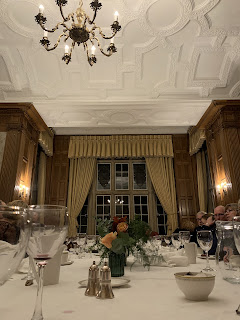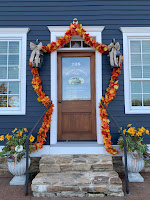Travellers familiar with the towering white walls of the Seven Sisters on the Kent Coast, or with Ireland’s spectacular coastline at Moher, may find the Danish deployment of the word “cliffs” at Stevns a somewhat amusing. Though composed of sparkling white chalk like their cousins around Dover, the cliffs of Stevns … called Stevns Klint locally … are just 130 feet at their highest and much lower for most of the 11 miles they run along the Baltic. So on first glance the fact that the cliffs have been named a UNESCO World Heritage site can be perplexing.
It’s not the size that makes these cliffs important, it turns out, but a wrinkle of geology.
Stevns is the best place in the world to see a long line of fish clay, known to scientists as the K-Pg Boundary, that separates the age of the dinosaurs from the rise of the mammals. It helped scientists Luis and Walter Alvarez develop and prove their theory that the dinosaurs were wiped out by the impact of a giant asteroid on the Earth.
You wouldn’t have thought that was enough to base a museum around, much less to captivate punters for well over an hour, but this place is well worth a visit even if you think geology sounds boring. It’s not … and this may just change your mind. You’ll also be quite the trend setter; the museum was only opened by Queen Margrethe two months ago.
The beautiful, modern building is sunk into the cliff top, entirely invisible from the road and only really seen to its full beauty if you’re on the cliff walk about half a mile away. In between is a defunct limestone quarry, the source for many of Copenhagen’s grand 19th century stone facades, now part of the site's redevelopment as a cultural centre. It’s the massive hole left by stone extraction that now allows the museum to burrow into the limestone like a Bond villain’s lair.
Inside, an open plan space runs the length of the quarry-fronting windows, its sleek, white design reminiscent of a modern concert hall. A grand piano reinforces that perception; they host concerts here and the aunt who showed us around said the acoustics are surprisingly good, despite all those hard surfaces. Under normal circumstances, however, most of the space is taken up with a shop selling local crafts (jewellery and decorative items crafted from the limestone, watercolours, wood working, local honey) and a surprisingly good cafe with gourmet sandwiches, thick soups and local beers. My husband's aunt, who lives in walking distance, says the cafe is becoming popular with neighbours who go to the museum just for the food, and for walkers who use the car park to start cliff walks from here.
The museum stretches along the length of this space, but on the side dug into the cliff. You start in a theatre with a massive block of limestone taking centre stage, K-Pg line visible along its length. Even when the lights go down, its pristine whiteness glimmers in the dark. Then comes a film designed to use the odd projection space … stone at the front, stage around and behind … to dramatic effect. The stone appears and disappears as we learn how it came to be. You can ask for it to be run in English but, to be honest, the graphics are so good you don’t need to. There’s an ocean with a vibrant ecosystem living, dying and sinking its bones into the sea bed below that will become the base of our cliffs. Continents shift and it becomes a jungle, with dinosaurs stomping through. Then comes the asteroid, and a frighteningly effective cataclysm blasting through the room with more sound and light. And then primitive mammals emerge from their hiding places to forge a new world.
After the film, a long gallery with multiple displays fills in the details, with all signage in Danish and English. There’s more on dinosaurs and fossils, with some skeletons kids will love. An entertaining tree of life, projected with light and growing from source to today every few minutes, shows how everything on earth connects to those lucky asteroid survivors. The movie explaining how the Alavrezes came to, and proved, their theory is a case study in how to use solid storytelling principles to make the complicated simple. Honestly, you can say that about the whole place. And there’s a highly entertaining table at the far end where you can play God, sending the asteroid towards Earth time and again to see the different ill effects. Show me the tsunami! This time, obliterate sunlight!
Given the horrors of the table of doom, it’s a good thing that the curators choose this time to point out the low statistical chances of this happening again and allowing you to dig into the variety of NASA-led global plans to stop an incoming asteroid should one appear. At this point, any American or English museum would doubtless have inserted a section on asteroid cataclysms in film history from Armageddon to Don’t Look Up, with Aerosmith’s Don’t Want to Miss a Thing on the sound system and an opportunity to have your photo with a cut out of Bruce Willis and Ben Affleck saving the world.
But the Danes are too classy for that. Instead, you head out through a glass tunnel called the triumph of life, where exquisitely taxidermised examples of today’s animal kingdom flock, prance, stroll and slither around you. The swan extended to full wingspan above you is a wonder to behold, but it’s the red panda all the kids will want to bring home. Cuddly toy animals are available in the gift shop, naturally.
There are plans afoot to develop the artificial valley of the quarry, hopefully including the rescue of a magnificent turn-of-the-20th century round barn made entirely of wood. We walked through it and it’s a spectacular space. The cliff walks are lovely and there are some pretty beaches. Book a room at Rødvig Kro (Inn) and make a weekend of it. For now, this is well off the beaten track but just an hour from Copenhagen, making it an excellent side trip from the usual urban visit.










































